African penguin
The African penguin (Spheniscus demersus), also known as the Cape penguin or South African penguin, is a species of penguin confined to southern African waters. Like all extant penguins, it is flightless, with a streamlined body and wings stiffened and flattened into flippers for a marine habitat. Adults weigh an average of 2.2–3.5 kg (4.9–7.7 lb) and are 60–70 cm (24–28 in) tall. The species has distinctive pink patches of skin above the eyes and a black facial mask. The body upperparts are black and sharply delineated from the white underparts, which are spotted and marked with a black band. The pink glands above their eyes help them with thermoregulation. To cope with changing temperatures, blood is sent to the glands to be cooled by the air.[2]
| African penguin | |
|---|---|
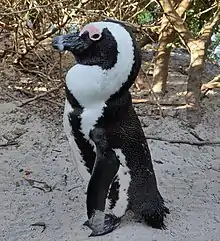 | |
| At Boulders Beach in Cape Town, South Africa | |
| Scientific classification | |
| Kingdom: | Animalia |
| Phylum: | Chordata |
| Class: | Aves |
| Order: | Sphenisciformes |
| Family: | Spheniscidae |
| Genus: | Spheniscus |
| Species: | S. demersus |
| Binomial name | |
| Spheniscus demersus | |
 | |
| Distribution of the African penguin | |
| Synonyms | |
| |
The African penguin is a pursuit diver, and feeds primarily on fish and squid. Once extremely numerous, the African penguin is declining rapidly due to a combination of several threats and is classified as endangered. It is a charismatic species and is popular with tourists. Other vernacular names of the species include black-footed penguin and jackass penguin, due to the species' loud, donkey-like bray,[3] although several related species of South American penguins produce the same sound. They can be found in South Africa, Namibia, Angola, the Democratic Republic of the Congo, Gabon and Mozambique.
Taxonomy
The African penguin was one of the many bird species originally described by Carl Linnaeus in the landmark 1758 10th edition of his Systema Naturae, where he grouped it with the wandering albatross on the basis of its bill and nostril morphology and gave it the name Diomedea demersa.[4]
The African penguin is a banded penguin, placed in the genus Spheniscus. The other banded penguins are the African penguin's closest relatives, and are all found mainly in the Southern Hemisphere: the Humboldt penguin and Magellanic penguins found in southern South America, and the Galápagos penguin found in the Pacific Ocean near the equator. All are similar in shape, colour and behaviour.
The African penguin is a member of the class Aves and the order Sphenisciformes. It belongs to the penguin family Spheniscidae, and is classified as Spheniscus demersus. The genus to which the African penguin belongs, Spheniscus, derives its name from the Ancient Greek word sphen ('wedge'), referring to their streamlined body shape. Its species name, demersus, is a Latin word for "plunging".[5]
Description
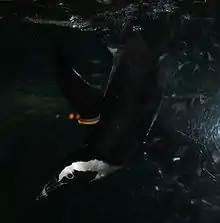
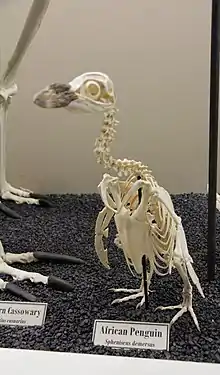
African penguins grow to 60–70 cm (24–28 in) tall and weigh between 2.2–3.5 kg (4.9–7.7 lb).[6] They have a black stripe and black spots on the chest, the pattern of which is unique to each penguin, like human fingerprints. The sweat glands above the eyes cool the birds' blood, and as the temperature rises, increased blood flow causes the glands to get more pink.[7] This species exhibits slight sexual dimorphism; the males are slightly larger than the females and have longer beaks.[8] Juveniles do not possess the bold, delineated markings of the adult, but instead have dark upperparts that vary from greyish-blue to brown; the pale underparts lack both spots and the band. The beak is more pointed than that of the Humboldt. The African penguin's colouring is a form of protective colouration known as countershading. The white undersides of the birds are difficult to spot by predators under the water, and the penguins' black backs blend in with the water when viewed from above.
African penguins resemble and are thought to be related to the Humboldt, Magellanic, and Galápagos penguins.[2] African penguins have a very recognisable appearance, with a thick band of black that in the shape of an upside-down horseshoe. They have black feet and black spots that vary in size and shape between individuals. Magellanic penguins share a similar bar marking that often confuses the two; Magellanics have a double bar on the throat and chest, whereas the African has a single bar. These penguins have the nickname "jackass penguin", which comes from the loud noises they make.
Distribution and habitat
The African penguin is only found on the south-western coast of Africa, living in colonies on 24 islands between Namibia and Algoa Bay, near Port Elizabeth, South Africa.[1] It is the only penguin species that breeds in Africa, and its presence gave name to the Penguin Islands.
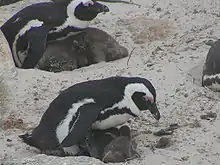
Two colonies were established by penguins in the 1980s on the mainland near Cape Town, namely Boulders Beach near Simon's Town and Stony Point in Betty's Bay. Mainland colonies likely became possible only in recent times due to the reduction of predator numbers, although the Betty's Bay colony has been attacked by leopards.[9][10] The only other mainland colony is in Namibia, but it is not known when it was established.
Boulders Beach is a tourist attraction due to the beach, swimming and the penguins.[11][12] The penguins will allow people to approach them as close as a metre.
Breeding populations of African penguins are being kept in numerous zoos worldwide. No colonies are known outside the south-western coast of Africa, although vagrants (mostly juveniles) may occasionally be sighted beyond the normal range.
Population
Roughly 4 million African penguins existed at the beginning of the 19th century. Of the 1.5 million African penguins estimated in 1910, only some 10% remained at the end of the 20th century. African penguin populations, which breed in Namibia and South Africa, have declined by 95 percent since pre-industrial times.[13]
Today, their breeding is largely restricted to 24 islands from Namibia to Algoa Bay, South Africa,[14] with the Boulders Beach colony being an exception to this rule.
The total population fell to approximately 150,000–180,000 in 2000.[15][16] Of those, 56,000 belonged to the Dassen Island colony and 14,000 to the Robben Island colony.[17] The colony at Dyer Island in South Africa fell from 46,000 in the early 1970s to 3,000 in 2008.[18]
In 2008, 5,000 breeding pairs were estimated to live in Namibia.
In 2010, the total African penguin population was estimated at 55,000. At the rate of decline seen from 2000 to 2010, the African penguin is expected to be extinct in the wild by 2026.[19]
In 2012, about 18,700 breeding pairs were estimated to live in South Africa, with the majority on St. Croix Island in Algoa Bay.[1][20]
The total breeding population across both South Africa and Namibia fell to a historic low of about 20,850 pairs in 2019.[21]
Behaviour
Diet
African penguins forage in the open sea, where they pursue pelagic fish such as sardines and anchovies (specifically the Southern African anchovy),[22] and marine invertebrates such as squid and small crustaceans.[23] Penguins normally swim within 20 km (12 mi) of the shore.[6] A penguin may consume up to 540 grams (1.19 lb) of prey every day,[24] but this may increase to over 1 kg (2.2 lb) when raising older chicks.[23]
Due to the collapse of a commercial pilchard (sardine) fishery in 1960, the African penguin's diet has shifted towards anchovies to some extent, although available pilchard biomass is still a notable determinant of penguin population development and breeding success. While a diet of anchovy appears to be generally sufficient, it is not ideal due to anchovies' lower concentrations of fat and protein. Penguin diet changes throughout the year; as in many seabirds, it is believed that the interaction of diet choice and breeding success helps the penguins maintain their population size. Although parent penguins are protective of their hatchlings, they will not incur nutritional deficits themselves if prey is scarce and hunting requires a greater time or energy commitment. This may lead to higher rates of brood loss under poor food conditions.
When foraging, African penguins carry out dives that reach an average depth of 25 m (82 ft) and last for 69 s, although a maximum depth of 130 m (430 ft) and duration of 275 s has been recorded.[25]
Breeding
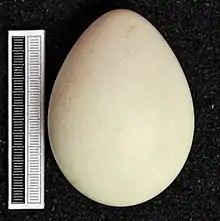
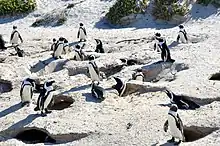
The African penguin is monogamous.[5] It breeds in colonies, and pairs return to the same site each year. The African penguin has an extended breeding season,[5] with nesting usually peaking from March to May in South Africa, and November to December in Namibia.[22] A clutch of two eggs are laid either in burrows dug in guano, or scrapes in the sand under boulders or bushes. Incubation is undertaken equally by both parents for around 40 days. At least one parent guards the chicks for about one month, whereafter the chicks join a crèche with other chicks and both parents head out to sea to forage each day.
Chicks fledge at 60 to 130 days, the timing depending on environmental factors such as the quality and availability of food. The fledged chicks then go to sea on their own, where they spend the next one to nearly two years. They then return to their natal colony to molt into adult plumage.[5]
When penguins molt, they are unable to forage as their new feathers are not yet waterproof; therefore, they fast over the entire molting period.[5] African penguins take around three weeks to molt, and lose almost half their body weight by using up their fat reserves in the process.[26]
Female African penguins remain fertile for 10 years. African penguins spend most of their lives at sea until it comes time for them to lay their eggs. Due to high predation on the mainland, African penguins will seek protection on offshore islands, where they are safer from larger mammals and natural challenges. These penguins usually breed during the winter when temperatures are lower. African penguins often will abandon their eggs if they become overheated in the hot sun, and abandoned eggs do not survive the heat. Ideally, eggs are incubated in a burrow dug into the guano layer (which provides suitable temperature regulation), but the widespread human removal of guano deposits has rendered this type of nest unfeasible at many colonies. To compensate, penguins dig holes in the sand, breed in the open, or make use of nest boxes if they are provided. The penguins spend three weeks on land to provide for their offspring, after which chicks may be left alone during the day while the parents forage. The chicks are frequently killed by predators or succumb to the hot sun. The eggs are three to four times bigger than hen's eggs. Parents usually feed hatchlings during dusk or dawn.
In 2015, when foraging conditions were favorable, more male than female African penguin chicks were produced in the colony on Bird Island. Male chicks also had higher growth rates and fledging mass, and therefore may have higher post-fledging survival than females. This, coupled with higher adult female mortality in this species, may result in a male biased adult sex ratio and may indicate that conservation strategies focused on benefiting female African penguins may be necessary.[27]
Predation
The average lifespan of an African penguin is 10 to 27 years in the wild, and up to 30 in captivity.[28]
Primary predators of African penguins include sharks and fur seals. While nesting, kelp gulls, mongooses, caracals, Cape genets and domestic cats and dogs may prey on the penguins and their chicks.[29][30] Mortality from terrestrial predators is higher if penguins are forced to breed in the open in the absence of suitable burrows or nest boxes.
Threats and conservation
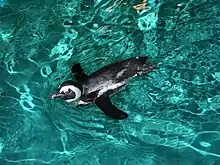
Historical exploitation
African penguin eggs were considered a delicacy, and were still being collected for sale as recently as the 1970s. In the 1950s, they were being collected from Dassen Island and sold in nearby towns.[31] In 1953, 12,000 eggs were collected.[32] In the late 1950s, some French chefs expressed interest in recipes including African penguin eggs collected from the islands off South Africa's west coast, and placed annual orders for small quantities.[33][34][35] In the mid 1960s, eggs were collected in the thousands and sold by the dozen,[36] with each customer limited to two dozen eggs in total.[37]
The practice of collecting African penguin eggs involved smashing those found a few days prior to a collecting effort to ensure that only freshly laid eggs were sold. This added to the drastic decline of the African penguin population around the Cape coast, a decline which was hastened by the removal of guano from islands for use as fertiliser, eliminating the burrowing material used by penguins.[38]
Oil spills
Penguins remain susceptible to pollution of their habitat by petrochemicals from spills, shipwrecks and cleaning of tankers while at sea. Accounts of African penguins impacted by oil date back to the 1930s.[39] African penguins' exposure to oil spills is both chronic (higher frequency small discharges of oil at sea) and acute (rare maritime disasters where large volumes of oil are released in a single event). Penguins of many species have been impacted by oil spills across the southern hemisphere.
In 1948, the tanker Esso Wheeling sank, subsequently oiling and killing thousands of penguins of the Dyer Island colony.[40] In 1953, dead penguins were among a range of dead birds, fish and other marine life that washed ashore after the tanker Sliedrecht was holed and spilled oil near Table Bay.[41] In 1971, the SS Wafra oil spill impacted the African penguin colony of Dyer Island. In 1972, oil spilled following the Oswego-Guardian and Texanita collision oiled roughly 500 penguins.[42] In 1975, newspapers reported that oil pollution from shipwrecks and the pumping of bilges at sea had killed tens of thousands of African penguins. At the time, the Dassen Island colony was being passed by 650 oil tankers each month[43] because the Suez Canal had become blocked with wrecked vessels, thus increasing maritime traffic past the Cape of Good Hope.[42]
In 1979, an oil spill prompted the collection and treatment of 150 African penguins from St. Croix Island near Port Elizabeth. The animals were later released at Robben Island and four of them promptly swam back to St. Croix Island, surprising scientists.[44][45]
In 1983, the exposure of penguins of Dassen Island to the oil slick from the Castillo de Bellver was also a topic of concern given the penguins' conservation status at the time, but owing to prevailing wind and current, only gannets were oiled.[46]
1994 MV Apollo Sea disaster
African penguin casualties were significant following the sinking of the MV Apollo Sea and subsequent oil slick in 1994. 10,000 penguins were collected and cleaned, of which less than half survived.[47]
2000 MV Treasure crisis
Disaster struck on 23 June 2000, when the iron ore tanker MV Treasure sank between Robben Island and Dassen Island, South Africa. It released 400–1,000 tonnes (390–980 long tons; 440–1,100 short tons) of fuel oil, causing an unprecedented coastal bird crisis and oiling 19,000 adult penguins at the height of the best breeding season on record for this vulnerable species.[48] The oiled birds were brought to an abandoned train repair warehouse in Cape Town to be cared for. An additional 19,500 un-oiled penguins were removed from Dassen Island and other areas before they became oiled, and were released about 800 kilometres east of Cape Town, near Port Elizabeth. This gave workers enough time to clean up the oiled waters and shores before the birds could complete their long swim home (which took the penguins between one and three weeks). Some of the penguins were named and radio-tracked as they swam back to their breeding grounds. Tens of thousands of volunteers helped with the rescue and rehabilitation process, which was overseen by the International Fund for Animal Welfare (IFAW) and the South African Foundation for the Conservation of Coastal Birds (SANCCOB), and took more than three months to complete. This was the largest animal rescue event in history; more than 91% of the penguins were successfully rehabilitated and released – an amazing feat that could not have been accomplished without such a tremendous international response.[49]
Due to the positive outcome of African penguins being raised in captivity after tragedies such as the Treasure oil spill, the species is considered a good "candidate for a captive-breeding programme which aims to release offspring into the wild"; however, worry about the spread of new strains of avian malaria is a major concern in the situation.[50]
Bringing the birds inland led to the exposure of penguins to parasites and vector species such as mosquitoes, including mosquitoes carrying avian malaria, which has caused 27% of the rehabilitated penguin deaths annually.[51]
2016 & 2019 Port of Ngqura
Small scale oil spills (of less than 400 litres (110 US gal)) have occurred at the Port of Ngqura since bunkering activities started there in 2016. Bunkering is a ship refueling process that can result in oil spills and oil slicks entering the water. Hundreds of African penguins have been harmed following these spills,[52] due to the port's close proximity to penguin rookeries on St. Croix Island and seabird habitat on neighbouring Jahleel and Brenton Islands.
Competition with fisheries
Commercial fisheries of sardines and anchovy, the two main prey species of the penguins, have forced these penguins to search for prey farther offshore, as well as having to switch to eating less nutritious prey.[13] Restricting commercial fishing in the immediate vicinity of colony sites such as Robben Island for short periods (3 years) was shown to markedly improve penguin breeding success. Longer closure periods and closures near other colonies are being evaluated.[53][54][55]
Conservation status
The African penguin is one of the species to which the African-Eurasian Waterbird Agreement (AEWA) applies. In September 2010, it was listed as endangered under the US Endangered Species Act.[13] As of 2018, the African penguin is listed as endangered on the IUCN Red List. Its population is approximately 50,000 birds and declining.[56]
Mediation efforts
Many organisations such as SANCCOB, Dyer Island Conservation Trust, SAMREC and Raggy Charters with the Penguin Research Fund in Port Elizabeth are working to halt the decline of the African penguin. Measures include monitoring population trends, hand-rearing and releasing abandoned chicks, establishing artificial nests and proclaiming marine reserves in which fishing is prohibited.[1] Some colonies (such as on Dyer Island) are suspected to be under heavy pressure from predation by Cape fur seals and may benefit from the culling of individual problem animals,[54][57] which has been found effective (although requiring a large amount of management effort) in trials.[58]
Established in 1968, SANCCOB is currently the only organisation mandated by the South African government to respond to crises involving seabirds along South Africa's coastline and is internationally recognised for the role it played during the MV Treasure oil spill. A modeling exercise conducted in 2003 by the University of Cape Town's FitzPatrick Institute of African Ornithology found that rehabilitating oiled African penguins has resulted in the current population being 19 percent larger than it would have been in the absence of SANCCOB's rehabilitation efforts.[59]
In February 2015, the Dyer Island Conservation Trust opened the African Penguin and Seabird Sanctuary (APSS) in Gansbaai, South Africa.[60] The centre was opened by then-Department of Tourism minister Derek Hanekom,[61] and will serve as a hub for seabird research carried out by the Dyer Island Conservation Trust. The centre will also run local education projects, host international marine volunteers, and seek to improve seabird handling techniques and rehabilitation protocols.
Captivity
.jpg.webp)
African penguins are a commonly seen species in zoos across the world. Because they do not require particularly low temperatures, they are often kept in outside enclosures. They adapt fairly well to this captive environment, and are rather easy to breed compared to other species of the family. In Europe, the breeding program EEP is regulated by Artis Royal Zoo in the Netherlands, whilst in the United States, the SSP program is coordinated by the Smithsonian National Zoological Park. The idea is to create a backup captive population, as well as to aid in the conservation of the population in its natural habitat. Between 2010 and 2013, American zoos spent $300,000 on in-situ (wild population) conservation.[62][63]
Gallery
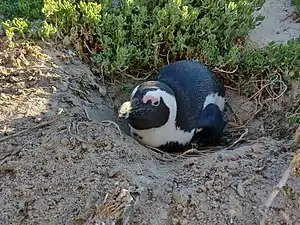 Nesting African penguin
Nesting African penguin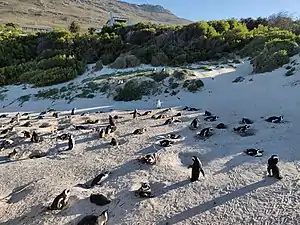 Colony of African penguins nesting on Boulders Beach in Cape Town
Colony of African penguins nesting on Boulders Beach in Cape Town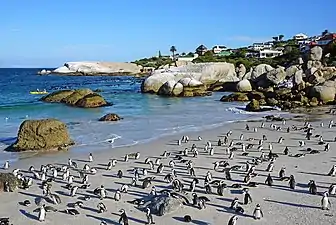 African penguins on Boulders Beach
African penguins on Boulders Beach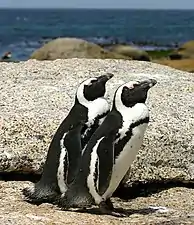 African penguins on a rock at Boulders Beach
African penguins on a rock at Boulders Beach
References
- BirdLife International (2018). Spheniscus demersus. The IUCN Red List of Threatened Species 2018. doi:10.2305/IUCN.UK.2018-2.RLTS.T22697810A132604504.en
- a-z animals. "The African Penguin". a-z animals. Retrieved 2013-07-09.
- Favaro, Livio; Ozella, Laura; Pessani, Daniela; Pavan, Gianni (30 July 2014). "The Vocal Repertoire of the African Penguin (Spheniscus demersus): Structure and Function of Calls". PLOS ONE. 9 (7): e103460. doi:10.1371/journal.pone.0103460. PMC 4116197. PMID 25076136.
- Linnaeus, Carl (1758). Systema Naturae per Regna Tria Naturae, Secundum Classes, Ordines, Genera, Species, cum Characteribus, Differentiis, Synonymis, Locis. Tomus I. Editio decima, reformata (in Latin). Holmiae: Laurentii Salvii. p. 132.
- "Penguins: African Penguins – Spheniscus demersus". Penguins.cl. Retrieved 2015-09-25.
- Sinclair, Ian; Hockey, Phil; Tarboton, Warwick; Ryan, Peter (2011). Sasol Birds Of South Africa. Struik. p. 22. ISBN 9781770079250.
- Mahard, Tyler (2012). "The Black-footed Penguin Spheniscus demersus". Wildlife Monthly. Retrieved 2012-11-20.
- "African Penguin (Speheniscus demersus)". Dyer Island Conservation Trust. Archived from the original on 2009-10-26.
- "The African Penguin". Bettysbay. 2010-04-08. Archived from the original on 2012-05-30. Retrieved 2012-03-30.
- "CapeNature increases protection from predators at Stony Point". CapeNature. Retrieved 2020-07-06.
- "Table Mountain National Park". SANParks. Retrieved 2012-03-30.
- "Boulders Beach, Swimming with Penguins – Swimming with Penguins in South Africa". Goafrica. 2010-06-14. Retrieved 2012-03-30.
- Kilduff, Catherine (2010-09-28). "Vanishing African Penguin, Threatened by Climate Change and Fishing, Wins Protections". seaturtles.org. Archived from the original on 2013-12-03.
- "Know your Georgia Aquarium penguins (2006)". The Atlanta Constitution. 2006-11-17. pp. G6. Retrieved 2020-05-09.
- "Penguins begin swim home (Treasure, 2000)". York Daily Record. 2000-10-12. p. 6. Retrieved 2020-05-09.
- "Penguins elude oil spill but fishermen open fire, South Africa (2000)". Calgary Herald. 2000-07-21. p. 12. Retrieved 2020-07-02.
- "Flight of the African penguin (2000)". Tampa Bay Times. 2000-07-08. p. 2. Retrieved 2020-05-09.
- "Experiments seek to house declining South African penguins (2009)". The Boston Globe. 2009-03-30. pp. A6. Retrieved 2020-05-09.
- "African Penguin; Endangered; Cape Town". Globalpost.com. 2011-06-19. Retrieved 2012-03-30.
- Makhado, A. B., B. N. Dyer, R. Fox, D. Geldenhuys, L. Pichegru, R. M. Randall, R .B. Sherley, L. Upfold, J. Visagie., L. J. Waller, P. A. Whittington, and R. J .M. Crawford. 2013. Estimates of numbers of twelve seabird species breeding in South Africa, updated to include 2012. Branch Oceans and Coasts, Department of Environmental Affairs, Cape Town.
- Sherley, R. B.; Crawford, R. J.; de Blocq, A. D.; Dyer, B. M.; Geldenhuys, D.; Hagen, C.; Kemper, J.; Makhado, A. B.; Pichegru, L.; Upfold, L.; Visagie, J.; Waller, Lauren J.; Winker, Henning (2020). "The conservation status and population decline of the African penguin deconstructed in space and time". bioRxiv. 10 (15): 8506–8516. doi:10.1101/2020.01.15.907485. PMC 7417240. PMID 32788996.
- "African penguin videos, photos and facts – Spheniscus demersus". ARKive. Archived from the original on 2012-03-22. Retrieved 2012-03-30.
- "The African Penguin Simons Town". Simonstown.com. Retrieved 2012-03-30.
- Crawford, R. J. M.; Ryan, P. G.; Williams, A. J. (1991). "Seabird consumption and production in the Benguela and western Agulhas ecosystems". South African Journal of Marine Science. 11 (1): 357–375. doi:10.2989/025776191784287709.
- Ropert-Coudert Y; Kato A; Robbins A; Humphries GRW (October 2018). "African Penguin (Spheniscus demersus)". The Penguiness book, version 3.0. Unpublished. doi:10.13140/RG.2.2.32289.66406.
- "African Penguin". Toronto Zoo. Retrieved 5 July 2020.
- Spelt, A.; Pichegru, L. (2017). "Sex allocation and sex-specific parental investment in an endangered seabird". Ibis. 159 (2): 272–284. doi:10.1111/ibi.12457.
- "ADW: Spheniscus demersus: Information". Animaldiversity.ummz.umich.edu. 2010-02-01. Retrieved 2012-03-30.
- Whittington, P. A.; Hofmeyr, J. H.; Cooper, J. (1996). "Establishment, growth and conservation of a mainland colony of Jackass Penguins Spheniscus demersus at Stony Point, Betty's Bay, South Africa". Ostrich. 67 (3–4): 144–150. doi:10.1080/00306525.1996.9639700.
- "African penguin". Neaq.org. Retrieved 2012-03-30.
- "Dassen Island African penguins (1955)". The Pantagraph. 1955-01-09. p. 10. Retrieved 2020-05-09.
- "Penguin playmates & egg exports, Dassen Island (1954)". Press and Sun-Bulletin. 1954-10-23. p. 4. Retrieved 2020-05-09.
- "French Gourmet Finds Penguin Egg Recipes (1959)". The Racine Journal-Times Sunday Bulletin. 1959-08-09. p. 17. Retrieved 2020-05-09.
- "Penguin-egg eating may spread (1959)". The Troy Record. 1956-07-23. p. 14. Retrieved 2020-05-09.
- "Penguin eggs sent to French eaters (1959)". The Daily Oklahoman. 1959-05-24. p. 48. Retrieved 2020-05-09.
- "Penguins' Eggs Again To Grace Gourmets' Tables (1965)". Arizona Daily Star. 1965-05-30. p. 32. Retrieved 2020-05-09.
- "Must Ration Penguin Eggs at $2.10 a Dozen (1965)". Sioux City Journal. 1965-05-09. p. 49. Retrieved 2020-05-09.
- Shannon, L. J.; Crawford, R. J. M. (1999). "Management of the African penguin Spheniscus demersus — insights from modelling". Marine Ornithology. 27: 119–128.
- "Oily penguin, South Africa (1936)". Hartford Courant. 1936-08-02. p. 70. Retrieved 2020-05-09.
- "Oil wrecks penguins of Dyer Island (Esso Wheeling, 1949)". The Morning Call. 1949-04-29. p. 22. Retrieved 2020-07-07.
- "Ship Oil Kills Fish, Penguins". Newcastle Sun (NSW: 1918-1954). 1953-11-03. p. 8. Retrieved 2020-05-09.
- "Brief History of Penguin Oiling in South African Waters | Animal Demography Unit". www.adu.uct.ac.za. Retrieved 2020-07-07.
- "South Africa's penguins die from oil pollution effects (1975)". Arizona Republic. 1975-05-01. p. 1. Retrieved 2020-05-09.
- ""Homing" Penguins Travel 500 Miles (1979)". The Charlotte News. 1979-09-17. p. 4. Retrieved 2020-05-09.
- "Penguins baffle scientists (1979)". The Daily News. 1979-09-18. p. 27. Retrieved 2020-05-09.
- "Split Supertanker Gets Slow Tow Out To Sea (Castillo de Bellver oil spill, 1983)". The Baytown Sun. 1983-08-08. p. 6. Retrieved 2020-05-09.
- Wolfaardt, A. C.; Underhill, L. G.; Altwegg, R.; Visagie, J. (2008). "Restoration of oiled African penguins Spheniscus demersus a decade after the Apollo Sea spill". African Journal of Marine Science. 30 (2): 421–436. doi:10.2989/ajms.2008.30.2.14.564. S2CID 85384818.
- "Penguins, rescue, rehabilitation, research, internships". Sanccob. Retrieved 2015-09-25.
- ""Jackass Penguins Freed after Rehab", National Geographic's Video News, June 17, 2009". National Geographic. 2009-06-17. Retrieved 2012-03-30.
- Barham, P. J.; L. G. Underhill; R. J. M. Crawford; R. Altewegg; T. M. Leshoro; D. A. Bolton; B. M. Dyer & L. Upfold (2008). "The efficacy of hand-rearing penguin chicks: evidence from African penguins (Spheniscus demersus) orphaned in the Treasure oil spill". Bird Conservation International. 18 (2). doi:10.1017/S0959270908000142.
- Grim, C. (2003). "Plasmodium juxtanucleare associated with mortality in black-footed penguins (Spheniscus demersus) admitted to a rehabilitation center". Journal of Zoo and Wildlife Medicine. 34 (3): 250–5. doi:10.1638/02-070. JSTOR 20460327. PMID 14582786. S2CID 41534960.
- "Refuelling under scrutiny as S. Africa penguins hit by oil spill". phys.org. Retrieved 2020-04-23.
- Sherley, R. B.; Underhill, L. G.; Barham, B. J.; Barham, P. J.; Coetzee, J. C.; Crawford, R. J.; Dyer, B. M.; Leshoro, T. M.; Upfold, L. (2013). "Influence of local and regional prey availability on breeding performance of African penguins Spheniscus demersus". Marine Ecology Progress Series. 473: 291–301. Bibcode:2013MEPS..473..291S. doi:10.3354/meps10070.
- Weller, Florian; Sherley, Richard B.; Waller, Lauren J.; Ludynia, Katrin; Geldenhuys, Deon; Shannon, Lynne J.; Jarre, Astrid (2016). "System dynamics modelling of the Endangered African penguin populations on Dyer and Robben islands, South Africa". Ecological Modelling. 327: 44–56. doi:10.1016/j.ecolmodel.2016.01.011.
- Sherley, Richard B.; et al. (2018). "Bayesian inference reveals positive but subtle effects of experimental fishery closures on marine predator demographics". Proceedings of the Royal Society B. 285 (1871): 20172443. doi:10.1098/rspb.2017.2443. PMC 5805942. PMID 29343602.
- International), BirdLife International (BirdLife (2018-08-08). "IUCN Red List of Threatened Species: Spheniscus demersus". IUCN Red List of Threatened Species. Retrieved 2020-07-10.
- Ludynia, K.; L. J. Waller; R. B. Sherley; F. Abadi; Y. Galada; D. Geldenhuys; R. J. M. Crawford; L. J. Shannon & A. Jarre (2014). "Processes influencing the population dynamics and conservation of African penguins on Dyer Island, South Africa". African Journal of Marine Science. 36 (2): 253. doi:10.2989/1814232X.2014.929027. S2CID 84659321.
- Makhado, A. B.; M. A. Meÿer; R. J. M. Crawford; L. G. Underhill & C. Wilke (2009). "The efficacy of culling seals seen preying on seabirds as a means of reducing seabird mortality". African Journal of Ecology. 47 (3): 335. doi:10.1111/j.1365-2028.2008.00966.x. hdl:11427/24160.
- Nel, D. C.; Crawford, R. J. M.; Parsons, N. J. (2003). "The conservation status and impact of oiling on the African penguin". In Nel, D. C.; Whittington, P. A. (eds.). Rehabilitation of Oiled African Penguins: a Conservation Success Story. Cape Town: BirdLife South Africa and Avian Demography Unit. pp. 1–7.
- "First Class African Penguin and Seabird Sanctuary Opens in Kleinbaai, Overberg". SceinicSouth. 2015-02-26. Retrieved 2015-03-12.
- ""Rehab center goes to the birds", iol SciTech, March 3, 2015". iol.co.za. 2015-03-03. Retrieved 2015-03-12.
- "African Penguin". aza.org.
- "Nature conservation project African penguin". artis.nl.
External links
| Wikimedia Commons has media related to: |
| Wikispecies has information related to Spheniscus demersus. |
- California Academy of Sciences Live African Penguin Cams
- Images and movies of the African penguin on ARKive
- African penguins from the International Penguin Conservation website
- African penguins at the Toronto Zoo
- Dyer Island Conservation Trust
- African Penguin and Seabird Sanctuary
- African penguins on Boulders Beach, south of Cape Town
- FitzPatrick Institute of African Ornithology: Conserving Benguela endemic seabirds
